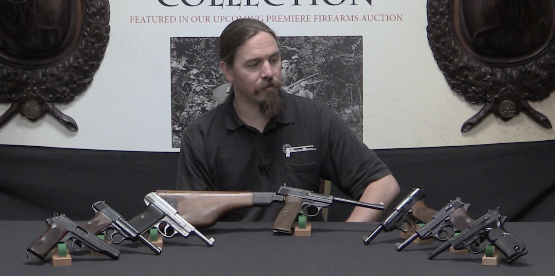This particular 1902-made example of the C96 Mauser incorporates several experimental features of the design that would never go into mass production. It was an effort to make a version of the C96 that would be more suitable for civilian carry – something a bit lighter and more compact than the military style. To this end, it has a smaller grip profile, a shorter barrel, and a shortened 6-round magazine. Most evidently, it also has an experimental safety that was intended to be more suitable for one-handed use. Unfortunately, the safety bit into the shooters hand badly with each shot, and only a few were ever made before the idea was dropped.
Related Articles

Select-fire Rifles
Transferable FG-42 at RIA
The undisputed star of the upcoming Rock Island Premier auction is this transferable full-auto German FG-42 paratrooper’s rifle. Only a few dozen of these are in private hands in the US, and they are an […]

Semiauto pistol
Luger automatic pistol
Ok, so the Luger isn’t exactly a Forgotten Weapon. In fact, it’s one of the most recognizable handguns ever made. But it traces its lineage directly so some much more obscure models (namely the Borchardt […]

Prototype
RIA: Walther P38 Development
The Walther P38 was adopted by Germany in 1938 as a replacement for the P08 Luger – not really because the Luger was a bad pistol, but because it was an expensive pistol. Walther began […]

IIRC, the original c/96 safety held the hammer locked but did nothing to secure the sear or trigger. Meaning, if the trigger was pressed when the gun was in Condition One, releasing the safety would drop the hammer and fire the piece. The NS “New Safety” locked sear and hammer both to avoid this booby-trap.
I always wondered why the Broomhandle never had a cross-bolt firing-pin safety. The block that secured the firing pin and concentric spring inside its barrel extension would have been a reasonable place for it. Just a sliding bar that locked the firing pin, and perhaps even withdrew it forward just far enough that if the hammer was dropped by accident, it couldn’t transfer the blow to the firing pin.
Such a safety would have been more reliable and probably a bit simpler to machine than any of the safeties they actually did use.
cheers
eon
NS safety does not lock the sear. It seems some confusement occured. Ît only holds the hammer at more distance form the sear and needs two hands to actuate.
[shoots mugger] “EEEYOWCH! Who designed this safety catch?”
I am afraid the 1902 safety might have been force matched to the frame during the restauration…
The 41676 is definitely made in 1905 and the frame is consistent with the period (small ring hammer) six-shooters, whereas the 1902 “Joint Safety” (Gelenkihe Sicherung) mechanism is only found (except this one) in 28,xxx-29,xxx range.
I was just at an auction in Rolla Missouri.
Lotd of c96 were on the block.
Joint Safety SN 50002 sold for $10,000